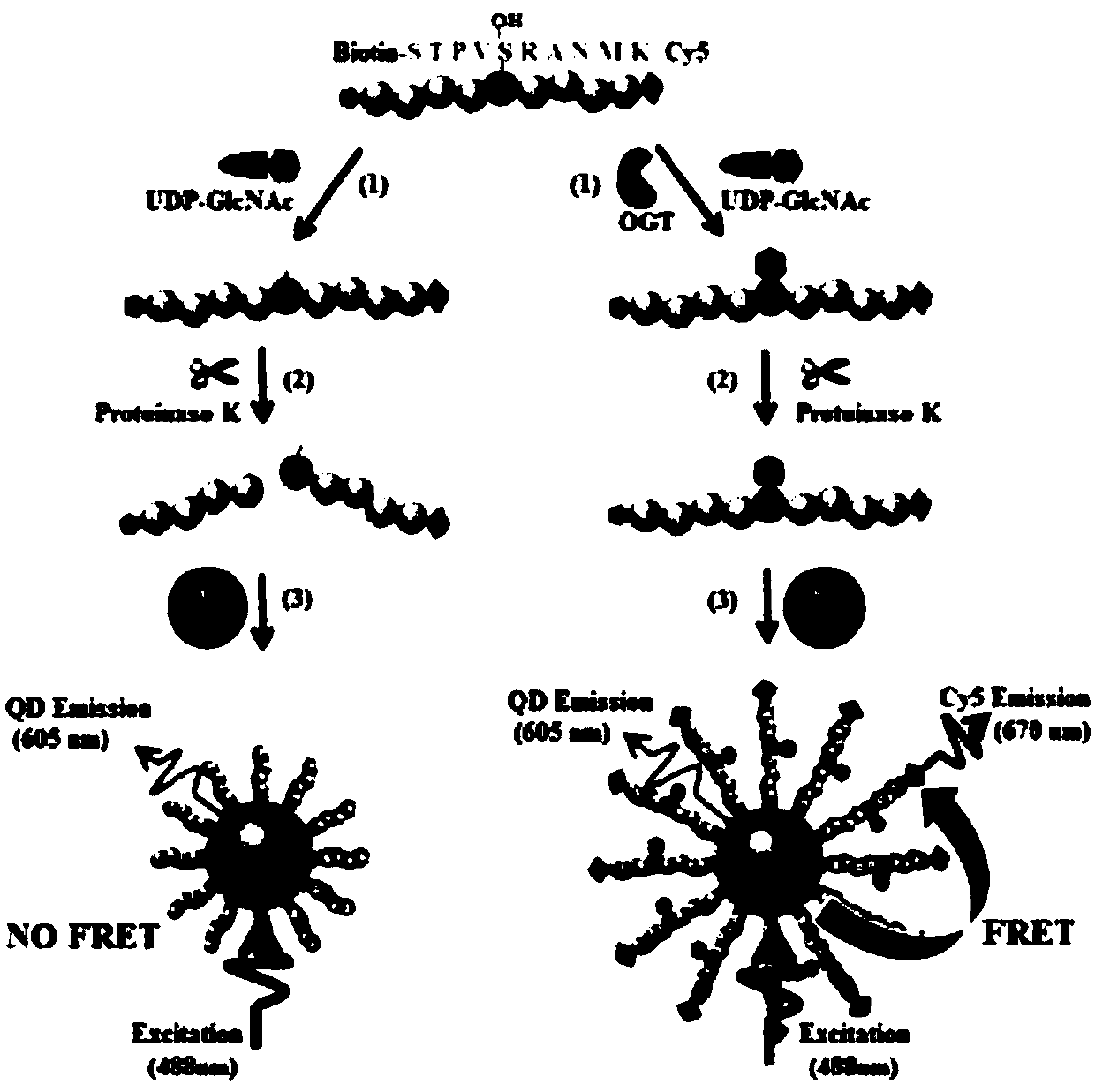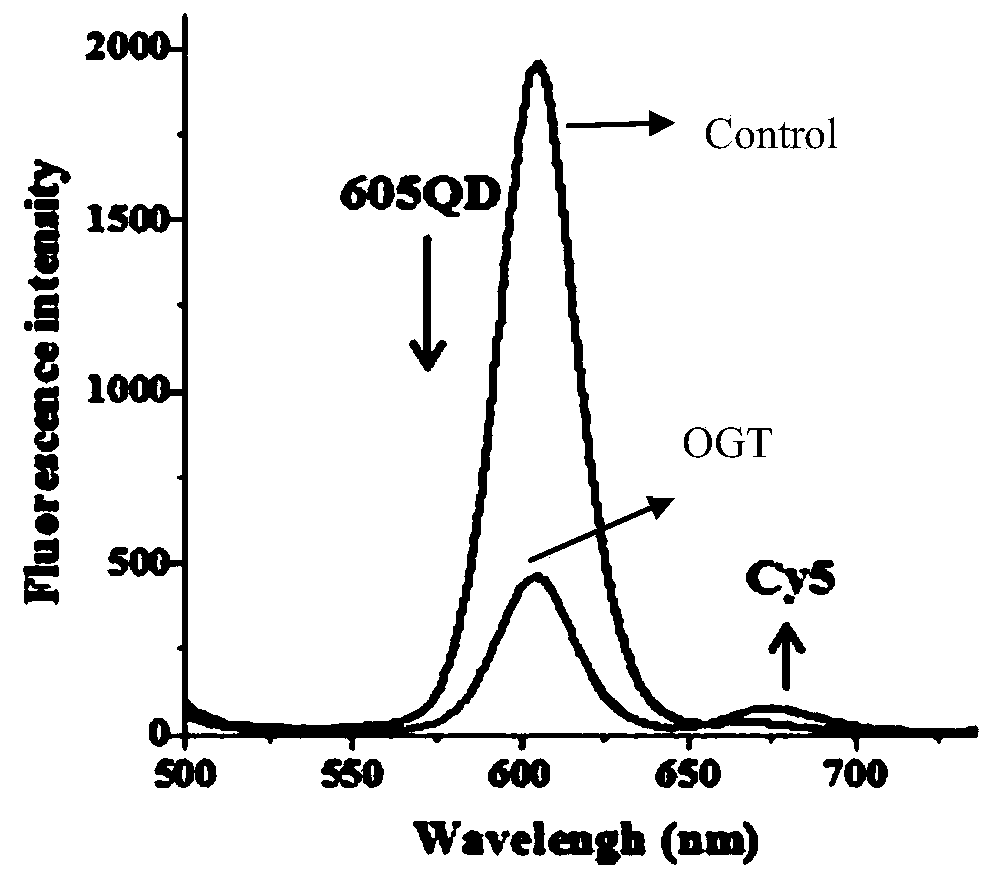Nano-sensor for detecting O-acetylglucosamine transferase and detection method of nano-sensor
An acetylglucosamine and nano-sensor technology, applied in biochemical equipment and methods, instruments, measuring devices, etc., can solve the problems of enzyme activity loss, poor sensitivity, low efficiency, etc., and achieve low cost, high sensitivity and high efficiency. Effect
- Summary
- Abstract
- Description
- Claims
- Application Information
AI Technical Summary
Problems solved by technology
Method used
Image
Examples
Embodiment 1
[0040] Example 1 A nanosensor for detecting O-acetylglucosamine transferase based on a single quantum dot
[0041] The nanosensor for detecting O-acetylglucosamine transferase based on a single quantum dot includes: cyanine 5 / biotin-modified peptide chain; non-radioactive uridine-acetylglucosamine, proteinase K and streptavidin-coated quantum dots. Wherein, the peptide chain modified by cyanine 5 / biotin is: Biotin-Ser-Thr-Pro-Val-Ser-Arg-Ala-Asn-Met-Lys-Cy5.
Embodiment 2
[0042] Example 2 A detection method of a nanosensor based on a single quantum dot to detect O-acetylglucosamine transferase
[0043] The detection method of described O-acetylglucosamine transferase comprises the following steps:
[0044] S1. Contains 2-3 μmol per liter of cyanine 5 / biotin-modified peptide, 90 μmol per liter of uridine-acetylglucosamine, 0.01 unit of alkaline phosphatase, OGT to be tested and 10× reaction buffer Solution, the total volume of the composition is 20 microliters of the reaction solution and incubated at 37 ° C for 1 hour; Calcium chloride, composed of 0.5% Tween-20 and 0.5% NP-40, pH value is 7.8;
[0045] S2. Add 1 nanogram of proteinase K to the glycosylation reaction product in a system with a total reaction volume of 30 microliters, and react at 50° C. for 1 hour;
[0046] S3. Take 20 microliters of the reaction product of step S2 and react with 5 nanomoles per liter of quantum dots in 100 microliters of incubation buffer at room temperature...
Embodiment 3
[0048] Example 3 A detection method of a nanosensor based on a single quantum dot to detect O-acetylglucosamine transferase
[0049] The detection method of described O-acetylglucosamine transferase comprises the following steps:
[0050] S1. Contains 2-3 micromoles per liter of cyanine 5 / biotin-modified peptide, 100 micromoles per liter of uridine-acetylglucosamine, 0.1 unit of alkaline phosphatase, OGT to be tested and 10× reaction buffer Solution, the total volume of the composition is 20 microliters of the reaction solution and incubated at 37 ° C for 1 hour; Calcium chloride, composed of 0.5% Tween-20 and 0.5% NP-40, pH value is 7.8;
[0051] S2. Add 2 nanograms of proteinase K to the glycosylation reaction product in a system with a total reaction volume of 30 microliters, and react at 60° C. for 3 hours;
[0052] S3. Take 40 microliters of the reaction product of step S2 and react with 15 nanomoles per liter of quantum dots in 100 microliters of incubation buffer at r...
PUM
 Login to View More
Login to View More Abstract
Description
Claims
Application Information
 Login to View More
Login to View More - R&D
- Intellectual Property
- Life Sciences
- Materials
- Tech Scout
- Unparalleled Data Quality
- Higher Quality Content
- 60% Fewer Hallucinations
Browse by: Latest US Patents, China's latest patents, Technical Efficacy Thesaurus, Application Domain, Technology Topic, Popular Technical Reports.
© 2025 PatSnap. All rights reserved.Legal|Privacy policy|Modern Slavery Act Transparency Statement|Sitemap|About US| Contact US: help@patsnap.com



